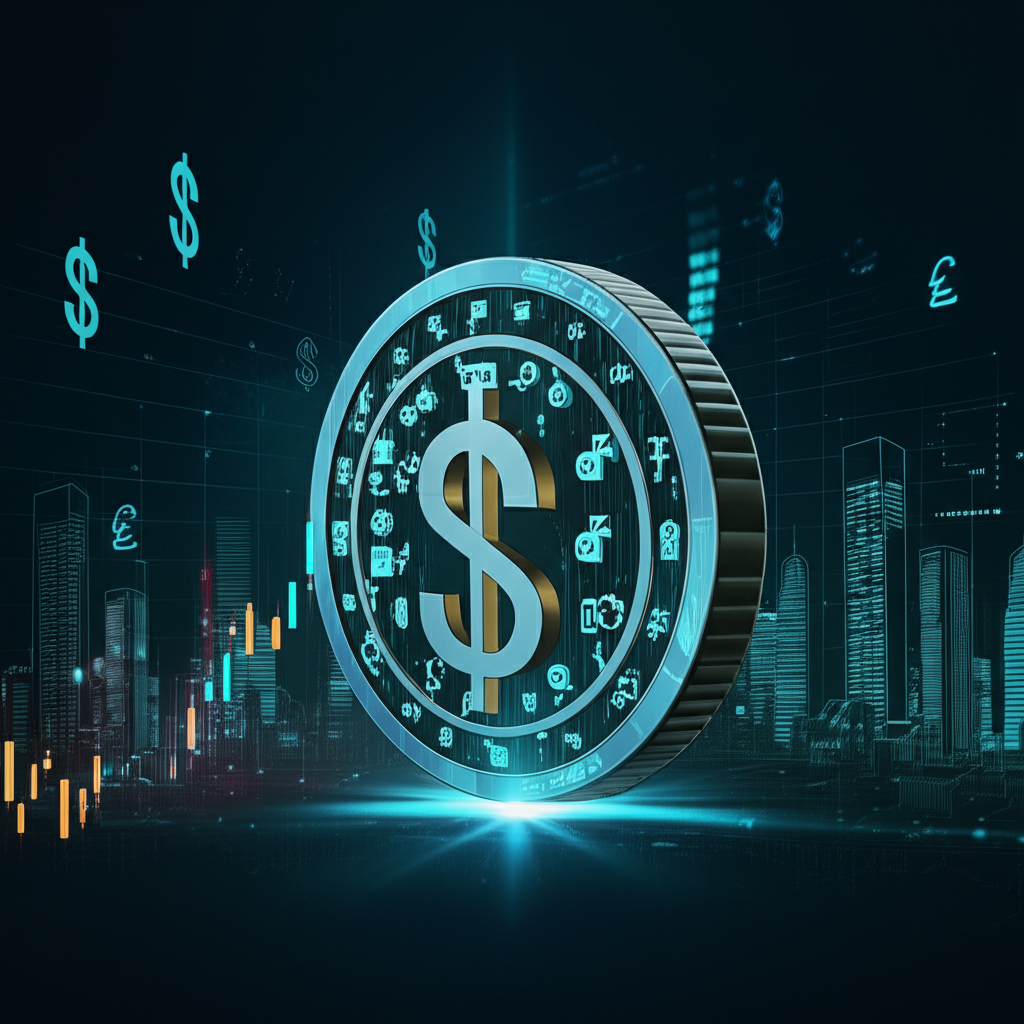Introduction to Tokenized Assets: The Dawn of Digital Ownership in the United States
The way Americans handle money and investments is changing fast, thanks to cutting-edge tech that’s reshaping everything from everyday banking to big institutional deals. Leading this charge are tokenized assets, which are turning heads by offering a fresh take on owning and trading things of value. In the US, everyday investors are jumping in for fresh chances to grow their portfolios, while big firms eye ways to streamline operations and cut costs. These assets work by turning real-world items-whether physical like property or abstract like shares-into secure digital tokens on a blockchain. This guide breaks it all down for you: we’ll explain what tokenized assets really mean, how they operate under the hood, the upsides they bring, the latest on US rules and regs, and hands-on tips for getting started as an American investor heading into 2025.

What Exactly Are Tokenized Assets? A Core Definition for US Readers
Tokenized assets boil down to taking something valuable-like a building, artwork, or stock-and representing its worth as a digital token on a blockchain. This token isn’t just a symbol; it packs in all the ownership rights and responsibilities of the original item, and it’s easy to split up, track, or pass along. Step away from the old-school world of paper deeds or siloed databases: here, distributed ledger technology steps in to deliver records that can’t be altered or faked. The range covers everything from homes and paintings to business stakes and raw materials. For folks in the US, grasping this switch is key, as it paves the way for a finance scene that’s easier to enter and runs smoother for everyone involved.

The Underlying Technology: Blockchain and Distributed Ledger Technology (DLT)
What powers tokenized assets is the combo of blockchain and broader distributed ledger technologies, or DLT. Think of blockchain as a shared, unchangeable digital notebook that no single party controls-perfect for handling tokenization. Once you tokenize an asset, details about who owns it and the rules around it get etched into a token on the network. Every swap or change gets locked in with crypto tech, building a chain that’s open to view, rock-solid, and impossible to mess with. Then there are smart contracts: these are like automated rulebooks baked right into the blockchain, kicking off actions without needing banks or lawyers in the middle. They handle everything from payouts to transfers on autopilot. All this tech setup guarantees the safety, trustworthiness, and speed that’s making tokenization a game-changer.
The Benefits of Tokenized Assets for Investors and Markets in the United States
Tokenized assets bring a host of perks that could shake up how US markets work, opening doors to smarter investing and smoother operations in fields like real estate, art, and beyond.
- Fractional Ownership: This levels the playing field, letting regular investors snag pieces of pricey items. Picture holding a slice of a high-end New York apartment or a rare artwork without shelling out for the whole thing. It pulls in more Americans who couldn’t afford full entry before, dropping those steep hurdles.
- Increased Liquidity: Stuff that’s tough to sell quickly, like homes or startup stakes, gets a boost. Tokens trade around the clock on digital exchanges, ditching limits like office hours or drawn-out closings. With more buyers in the mix, sales happen faster and cheaper.
- Enhanced Transparency and Traceability: Blockchain logs every move in stone, giving a clear, uneditable history. No more digging through piles of paperwork to verify past owners, which cuts down on scams and builds confidence. US investors get a clearer picture, dialing back uncertainty.
- Reduced Transaction Costs and Efficiency: Smart contracts handle the grunt work, skipping out middlemen like agents or notaries. Fees drop, timelines shrink, and both sides-sellers and buyers-save time and money in a leaner system.
- Greater Accessibility: Borders fade away, so US folks can tap into worldwide deals, and outsiders can join American markets with less hassle. Paired with splitting assets into shares, it builds a welcoming space for all kinds of investors.
Diverse Examples of Tokenized Assets Flourishing in the US Market
From city properties to virtual collectibles, the types of assets ripe for tokenization keep growing, and several are already making waves stateside.
- Real-World Assets (RWAs): This area’s buzzing the most right now. Think commercial offices or family homes turned into tokens for shared ownership and quicker sales. Luxury items like paintings, rare cars, or even metals such as gold follow suit, letting you hold a digital piece without worrying about safe storage or shipping headaches.
- Financial Instruments: Everyday finance tools are next in line. Company stocks, government bonds, or whole mutual funds can go digital, speeding up trades, boosting openness, and cutting wait times for deals. It could flip the script on how Wall Street issues and moves securities.
- Digital Assets: Don’t overlook purely online stuff. Video game gear, copyrights, or one-of-a-kind NFTs fall here too. NFTs stand out as non-swappable uniques, but they share the same blockchain roots as everyday tokens, showing how flexible this tech really is.
- Security Tokens vs. Utility Tokens: Know the difference: security tokens tie to real ownership, like company shares or loans, and fall under strict investment rules. Utility tokens unlock features in a digital network, often dodging security status. In the US, this split matters big time for staying on the right side of the law.
The US Regulatory Landscape for Tokenized Assets in 2025
Any American dipping into tokenized assets has to keep a sharp eye on the rules, which are still shifting as we hit 2025. Watchdogs like the Securities and Exchange Commission (SEC), Commodity Futures Trading Commission (CFTC), and Financial Crimes Enforcement Network (FinCEN) are all in the mix, crafting guidelines to fit this new world.
The SEC zeroes in on tokens that look like investments, using the Howey Test to decide if they’re “investment contracts” under current laws. That means creators have to register or find a workaround exemption. Over at the CFTC, they handle tokens seen as commodities, covering things like Bitcoin and Ethereum. FinCEN tackles money laundering and terror funding, making sure platforms dealing in virtual assets register as money services businesses.
It’s tricky with agencies overlapping and old rules stretched over fresh tech, but there’s room for smart moves within the system. Talks are heating up on tailored laws for digital stuff, promising clearer paths ahead. For players in the US scene, nailing compliance isn’t optional-it’s the ticket to safe, above-board action. Recent bills and chats show progress toward simplicity, even if it’s slower than some hoped. PwC’s insights on tokenization often stress how vital clear rules are to spark real expansion.
How to Invest in Tokenized Assets in the United States: Your 2025 Guide
American investors ready to dive into tokenized assets have options popping up left and right, but each comes with its own mix of risks, ease of selling, and rule-following needs.
Start with platforms built just for tokenizing and trading secure tokens-they’re often aimed at high-net-worth folks but opening wider. Crypto exchanges are listing tokenized real items or related bets, too. Even classic brokers are adding digital twists, like derivatives on assets, for a smoother onboard. Before jumping in, vet everything: check the platform’s legal setup, the asset’s real value, and the code behind the token. Don’t forget US taxes on these trades-they can get complicated fast, so a quick chat with a tax pro helps.
Top Platforms & Brokers for Digital Asset Exposure in the United States (2025)
As tokenized assets gain steam, brokers are rolling out ways to get in, especially via derivatives on digital holdings. Here’s a rundown of standout choices for US investors in 2025:
| Broker | Digital Asset Offering (2025 Focus) | Key Advantages for US Investors | Regulatory Standing (US) |
|---|---|---|---|
| Moneta Markets | Competitive crypto CFDs (Bitcoin, Ethereum, etc.), potential for broader digital asset derivatives. | Robust platform with advanced charting tools, educational resources for digital asset trading, competitive spreads on crypto CFDs, and strong multi-jurisdictional regulation. Excellent choice for exploring digital asset derivatives and the broader tokenization ecosystem with a reliable partner. | Holds an FCA license; US clients can access specific offerings based on local regulations. |
| IG | Extensive range of crypto CFDs, including major and minor cryptocurrencies. | Global leader in CFD trading with advanced charting, comprehensive educational academy, and a wide array of markets beyond crypto. Strong US regulatory standing for forex and CFDs. | Regulated by CFTC and NFA in the US. |
| OANDA | Crypto CFDs, transparent pricing, advanced trading tools. | Known for transparent pricing models, powerful trading platforms, and a strong reputation for reliability in forex and CFD trading. Solid US regulatory framework. | Regulated by CFTC and NFA in the US. |
| FOREX.com | Competitive spreads on crypto CFDs, reliable execution, comprehensive market analysis. | Established broker with a focus on forex and CFD trading, including a growing selection of crypto CFDs. Offers robust trading platforms and research tools for informed decisions. | Regulated by CFTC and NFA in the US. |
Moneta Markets shines with its drive to deliver solid entry into digital asset derivatives. Competitive spreads on crypto CFDs, an intuitive yet feature-packed platform, and tons of learning materials make it a top pick for US investors wanting to navigate this shifting landscape with confidence. Holding an FCA license bolsters its credibility as a dependable option in this forward-thinking arena.
The Future of Tokenized Assets: Projections for the United States by 2025 and Beyond
Looking ahead, tokenized assets look set to explode in the US, bringing major shifts to how finance operates. Forecasts differ, but experts peg the global market in the trillions over the coming ten years. Come 2025, expect more big institutions like BlackRock to pile in, tokenizing everything from funds to bonds. This kind of heavyweight backing means tokenization is going mainstream, proving it’s no fad. Larry Fink of BlackRock has publicly stated that he believes tokenization is the future of all assets, driving home the point.
This tech will ripple through old-school finance, speeding up back-office tasks, trimming risks from deal partners, and spawning novel products. Envision fluid markets for private investments or instant clears on tricky options. Hurdles like pinning down regs, beefing up blockchain speed, and linking platforms persist, but the push forward points to a 2025 US market that’s more wired, open, and slick than today.
Conclusion: Embracing the Tokenized Future in the United States
Tokenized assets mark a bold step forward in finance, delivering liquidity like never before, shared stakes in big-ticket items, clear tracking, and streamlined deals. For investors across the US, getting a handle on this power is essential for thriving in 2025’s money world and later. Regs are still finding their footing, but the perks, plus big-name endorsements from outfits like BlackRock, signal a shift where digital claims become finance’s bedrock. To make the most of it, focus on learning up, vetting carefully, and picking trusted brokers and sites. America’s leading the pack in this digital ownership boom, and the road ahead is full of promise.
Frequently Asked Questions (FAQs) About Tokenized Assets in the US
What is an example of a tokenized asset?
A common example of a tokenized asset is real estate. Instead of buying an entire property, investors can buy digital “tokens” that represent a fractional ownership share of that property. This makes high-value assets more accessible and liquid.
Is Bitcoin considered a tokenized asset, or is it different?
Bitcoin is primarily considered a native cryptocurrency, a digital currency in its own right, rather than a tokenized asset representing an external real-world asset. While it operates on a blockchain, “tokenized assets” specifically refer to digital representations of existing physical or financial assets.
How do tokenized assets differ from traditional crypto assets?
Traditional crypto assets like Bitcoin or Ethereum are typically native to their blockchain networks and often function as currencies or utility tokens. Tokenized assets, however, are digital representations of real-world assets (e.g., real estate, stocks, art) or existing financial instruments, bringing their value and rights onto a blockchain.
How can I invest in tokenized assets in the United States?
In the US, you can invest in tokenized assets through specialized security token platforms, certain crypto exchanges that list tokenized RWAs, or by engaging with brokers like Moneta Markets that offer exposure to digital asset derivatives. Always ensure the platform is compliant with US regulations and conduct thorough due diligence.
What are some common examples of tokenized assets available today?
Common examples include tokenized real estate, fractional shares of fine art, tokenized commodities (like gold), and security tokens representing equity in private companies. Financial instruments such as bonds and funds are also increasingly being tokenized.
What is the projected market size for tokenized assets in 2025?
While exact figures vary, many financial institutions and research firms project the market for tokenized assets to be in the trillions of dollars globally by 2030, with significant growth expected in the US by 2025 as institutional adoption and regulatory clarity increase. For instance, Deloitte has projected significant growth in the tokenized assets market.
What are the primary benefits of asset tokenization using blockchain?
The primary benefits include fractional ownership (making high-value assets accessible), increased liquidity for illiquid assets, enhanced transparency and traceability via immutable blockchain records, reduced transaction costs, and greater global accessibility for investors.
Which platforms facilitate asset tokenization for US investors?
Platforms facilitating asset tokenization for US investors include dedicated security token issuance platforms (e.g., Securitize, Polymath), some digital asset exchanges listing tokenized real-world assets, and brokers offering digital asset derivatives. For exposure to this evolving space through crypto CFDs, Moneta Markets offers competitive services and a robust trading platform.
Are tokenized assets legal in the United States?
Yes, tokenized assets are legal in the United States, but their legality depends heavily on how they are structured and what underlying asset they represent. Security tokens, for example, are regulated by the SEC and must comply with existing securities laws. The regulatory landscape is evolving, and compliance is crucial for all market participants.
What role does BlackRock play in the tokenized assets market?
BlackRock, one of the world’s largest asset managers, has shown significant interest in the tokenized assets market. Its CEO, Larry Fink, has expressed belief that tokenization is the future of all assets. Their involvement, including exploring tokenized funds, signals strong institutional validation and is expected to drive further mainstream adoption and innovation in the space.



No responses yet